|
Because
the causes of schizophrenia are still unknown, treatments focus
on eliminating the symptoms of the disease. Treatments include
antipsychotic medications and various psychosocial treatments.
| News From NIH --Schizophrenia's strongest known genetic risk deconstructed--- Suspect gene may trigger runaway synaptic pruning during adolescence – NIH-funded study.
"...The gene, called C4 (complement component 4), sits in by far the tallest tower on schizophrenia's genomic "skyline" of more than 100 chromosomal sites harboring known genetic risk for the disorder. Affecting about 1 percent of the population, schizophrenia is known to be as much as 90 percent heritable, yet discovering how specific genes work to confer risk has proven elusive, until now." --Steam McCarroll and a team, including Harvard colleagues Beth Stevens, Ph.D., Michael Carroll, Ph.D., and Aswin Sekar , reported on their findings online Jan. 27, 2016 in the journal Nature.--Schizophrenia risk from complex variation of complement component 4
"Normally, pruning gets rid of excess connections we no longer need, streamlining our brain for optimal performance, but too much pruning can impair mental function," explained Thomas Lehner, Ph.D., director of the Office of Genomics Research Coordination of the NIH's National Institute of Mental Health (NIMH), which co-funded the study along with the Stanley Center for Psychiatric Research at the Broad Institute and other NIH components. "It could help explain schizophrenia's delayed age-of-onset of symptoms in late adolescence/early adulthood and shrinkage of the brain's working tissue. Interventions that put the brakes on this pruning process-gone-awry could prove transformative.
|
Approved
antipsychotic medications
Antipsychotic
medications have been available since the mid-1950's. The older
types are called conventional or "typical" antipsychotics. Some
of the more commonly used typical medications include:
TYPICAL
ANTIPSYCHOTIC MEDICATION
|
Drug
Name
|
Molecular
Structure
|
Mechanism
of Action
|
Use
|
| Chlorpromazine
(Thorazine) |
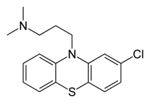 |
Chlorpromazine
acts as an antagonist (blocking agent) on different postsynaptic
receptors |
Chlorpromazine
is classified as a low-potency antipsychotic and in the
past was used in the treatment of both acute and chronic
psychoses, including schizophrenia and the manic phase of
bipolar disorder as well as amphetamine-induced psychoses.
|
| Haloperidol
(Haldol) |
 |
strong
central antidopaminergic action |
Used
in the treatment of schizophrenia and, more acutely, in
the treatment of acute psychotic states and delirium. |
| Perphenazine
(Trilafon)
|
 |
Binds
to the dopamine D1 and dopamine D2 receptors and inhibits
their activity. Perphenazine also binds the alpha adrenergic
receptor. |
Perphenazine
is used to treat psychosis (e.g. in schizophrenics) and
the manic phases of bipolar disorder. |
| Fluphenazine
(Prolixin). |
 |
Fluphenazine
blocks postsynaptic mesolimbic dopaminergic D1 and D2 receptors
in the brain |
as
a long acting injection given once every two or three weeks
to people with schizophrenia who have a poor compliance
with medication and suffer frequent relapses of illness. |
In the 1990's,
new antipsychotic medications were developed. These new medications
are called second generation, or "atypical" antipsychotics.
These
compounds share a receptor-blocking profile of less robust dopamine
blockade combined with greater serotonin blockade in comparison
with standard antipsychotic medications (i.e., dopamine D2 blockers).
Existing
drugs are reasonably good at treating the hallucinations and
delusions of schizophrenia. They are however far less effective
treating the negative symptoms of the disease e.g., the lack
of motivation and emotion that leave many patients unable to
work or have normal social relationships. The side effects of
existing medicines, are also severe. The older drugs like Chlorpromazine
can cause movement disorders; the newer atypicals have fewer
movement dissorders but can cause weight gain and other metabolic
changes
ATYPICAL
ANTIPSYCHOTIC MEDICATION
|
Drug
Name
|
Molecular
Structure
|
Mechanism
of Action
|
Use
|
| Risperidone
(Risperdal) |
 |
actions
at several 5-HT (serotonin) receptor subtypes,5-HT2C, 5-HT2A,
high affinity for D2 dopaminergic receptors |
used
to treat schizophrenia (including adolescent schizophrenia),
the mixed and manic states associated with bipolar disorder,
and irritability in children with autism. |
| Olanzapine
(Zyprexa) |
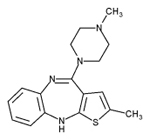 |
It
is a selective monoaminergic antagonist with high affinity
binding to serotonin 5-HT2A and 5-HT2C, dopamine D1-4, muscarinic
M1-5, histamine H1- and alpha1-adrenergic receptor sites.
|
schizophrenia;
treatment of acute mania episodes associated with bipolar
disorder (as monotherapy or in combination with lithium
or valproate); maintenance treatment of bipolar disorder;
acute agitation (patients with schizophrenia or bipolar
mania) |
| Quetiapine
(Seroquel) |
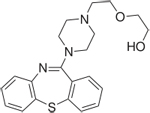 |
D1
and D2 dopamine receptor, the alpha-1 and alpha-2 adrenergic
receptor, and 5-HT1A and 5-HT2 serotonin receptor subtypes
are antagonized |
Quetiapine
is indicated for the treatment of schizophrenia, depressive
episodes associated with bipolar disorder, acute manic episodes
associated with bipolar I disorder |
| Ziprasidone
(Geodon) |
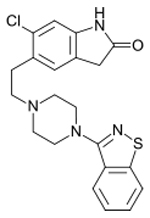 |
antagonism
at dopamine receptors, specifically D2. Serotonin
agonism may also play a role |
treatment of schizophrenia, acute treatment of mania and
mixed states associated with bipolar disorder |
| Aripiprazole
(Abilify) |
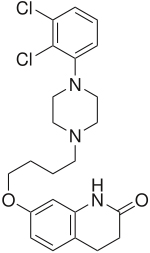 |
Rather
than antagonizing the D2 receptor, aripiprazole acts as
a D2 partial agonist. Aripiprazole is also a partial agonist
at the 5-HT1A receptor, and like the other atypical antipsychotics
displays an antagonist profile at the 5-HT2A receptor |
used
in the treatment of schizophrenia, bipolar disorder, and
clinical depression. |
| Paliperidone
(Invega) |
 |
therapeutic
effect may be due to a combination of D2 and 5-HT2A receptor
antagonism |
|
| Clozapine
(Clozaril) |
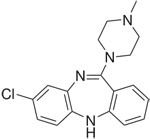 |
Blocks
dopamine4 receptors, serotonin2 receptors, norepinephrine
receptors, acetylcholine receptors, and histamine receptors
-- weakly blocks D2 receptors |
used
principally in treating treatment-resistant schizophrenia
--as a last resort medication.Clozapine can sometimes cause
a serious problem called agranulocytosis |
| Iloperidone
(Fanapt) new |
 |
block
the sites of noradrenaline (a2C), dopamine (D2A and D3),
and serotonin (5-HT1A and 5-HT6) receptors.
http://www.ncbi.nlm.nih.gov/pubmed/12818723
|
for
the treatment of schizophrenia -- less likely to cause movement
disorders and weight gain |
Drugs
in the Pipeline
Notes and
Updates on Pipeline Drugs:
Comments
on present drugs:
"ATI-9242
In vitro receptor profiling has demonstrated that ATI-9242 has
moderate D2 receptor affinity and a high 5HT2A/D2 binding ratio
characteristic of atypical antipsychotic agents. In addition,
ATI-9242 binds with high affinity to the 5HT7 receptor and exhibits
5HT1A partial agonist activity. In rat cortical neurons, ATI-9242
potentiates NMDA current and facilitates GABAergic neurotransmission.
In rats, it increases dopamine and acetylcholine in the prefrontal
cortex, with no measurable increase in the nucleus accumbens.
ATI-9242 has no antimuscarinic properties.
We believe
this product will improve upon the efficacy of the best atypicals
while avoiding metabolic drug-drug interactions and minimizing
certain other metabolic problems associated with atypicals,
including weight gain and type 2 diabetes. The receptor profile
of ATI-9242 is designed to treat negative symptoms of schizophrenia
- reduction in social interaction, disassociation from people
or settings, monotone speech, loss of feelings of pleasure -
and enhance cognitive functions". Source
"Blonanserin
is
a novel atypical antipsychotic agent with potent dopamine D(2)
and serotonin 5-HT(2) antagonist properties. It may potentially
have a lower incidence of adverse events than other antipsychotic
agents. Blonanserin was well tolerated at all doses and there
was no evidence of clinically important weight gain, orthostatic
hypotension, corrected QT interval prolongation or clinically
relevant changes in laboratory test results. Haloperidol caused
persistent elevation in prolactin levels, but this was not seen
with any dose of blonanserin throughout the study period. Blonanserin
was effective in the treatment of acute schizophrenia and showed
greater efficacy in negative symptoms compared with placebo
and haloperidol. Blonanserin was well tolerated and its safety
profile compared favourably with haloperidol, particularly with
respect to prolactin elevation and EPS frequency". Source
LY2140023
- also known as mGlu2/3 -- differs from established antipsychotic
drugs in that it targets glutamate rather than dopamine or serotonin
receptors. There is a substantial body of evidence to suggest
that glutamate, a neurotransmitter, may also be involved in
the pathophysiology of schizophrenia.
For decades,
psychiatrists have known that the street drug phencyclidine
(PCP) can induce symptoms almost identical to those of schizophrenia.
PCP acts as a NMDA glutamate receptor antagonist to non-competitively
block the NMDA subtype of the glutamate receptor. LY2140023,
an oral prodrug, is metabolised to the active mGlu2/3 receptor
agonist LY404039, which is believed to work by reducing the
presynaptic release of glutamate in those regions of the brain
where mGlu2/3 receptors are expressed.
Earlier
tests with LY2140023 -in about 200 patients had shown that the
drug worked quickly and safely without resulting in weight gain
and that the drug was effective in treating hallucinations,
delusions, social withdrawal and apathy. See Nature
Medicine Abstract. In the latest trial, the drug failed
to outperform Zyprexa. Lilly also said the drug did not outperform
a placebo. The response of patients to the placebo however,
was approximately double that normally seen in schizophrenia
clinical trials.
Ongoing
Studies with LY2140023 -- A
Safety Study Comparing LY2140023 to Atypical Antipsychotic Standard
Treatment in Schizophrenic Patients.
|

